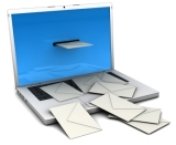6 Essential Email Etiquette Tips

Don't you just hate some emails?
These 6 email etiquette tips will improve your electronic communication, prevent misunderstandings and ultimately save yourself and others huge amounts of time.
Email is like any other powerful tool.
Used well, it can make life so much easier. Used poorly, it can cause unnecessary conflict and confusion, not to mention the time wasted having to deal with even more messages.
Try these email etiquette tips to make sure your messages are meaningful:
1. Use the subject line
This is so often overlooked. Make it crystal clear to the recipient what you are contacting them about, not just as a point of courtesy, but as a method for scanning for each email’s subject matter.
If several messages are bouncing around, starting with ‘Re:’ or some other cryptic message, raise the standard yourself! Reply to those people that need to know with a subject line that means something and helps someone.
2. Confirm receipt
If you get a direct request, let them know you’ll deal with it. Send a holding email, or set your auto responder to notify people you’ll get back to them by a specified time.
Include the original email(s) to make it easier to follow the thread of the discussion.
3. Maintain transparency
Emails are not private. You may think the recipient won’t pass it on,
but you can’t be sure. Never assume a message will stay secure.
A good rule of thumb is to ask yourself, ‘Would I be happy to have this read out in a law court?’ If not, re-read it and change what needs to be changed.
Email should be used to relay information. They’re most effective as a tool for relaying facts and figures, not emotions and feelings - save those for face to face meetings or hand written letters.
4. Keep it short and sweet
Use the minimum number of words you can but use as many as you need to politely convey the exact message you want to give,
Check your spelling, grammar and punctuation, particularly if it’s business related, and avoid abbreviations and acronyms unless you know the recipient will be familiar with them.
Don’t use capitals unnecessarily. THIS IS SEEN AS SHOUTING.
Here are two forms of content you should be very careful with:
- Humour*. This can so easily be misconstrued. What one person finds funny may be offensive to another. Unless you know each other well enough (and even then, be extremely careful), keep the funny stuff face to face.
- Negativity. Whether it’s bad news or an emotional reaction to something perceived as unpleasant, keep emails positive, or at least neutral in tone. Think about it -- this is for your own protection. What happens if the thread gets used as evidence for any reason?
*Remember that some spellings in British English (‘humour’) differ from American English ('humor’).
5. Avoid attachments
Do you have to send an attachment? Really? If so, send only what they need. We're all sick of them as it is, so attachments need to be worth the effort they take to open.
Oh, and if you’re sending something with an attachment, attach it first then write the message. That way it won’t get forgotten and have to be re-sent.
Finally, it helps to know the type of file you’re attaching. If it’s not commonly used, a brief explanation of how to open it helps (e.g. zip files).
6. Check before you send
The Golden Rule for email etiquette tips? Re-read it before you send it. This is a must-do every time. Whoever you send it to, make it a habit to check first.
Apart from checking what you say, check who you’re sending it to. We’ve all got got plenty of messages in our in boxes without being cc’d in to irrelevant information.
Make sure you choose ‘reply’ or ‘reply to all’ appropriately. Who really needs to know?
* * *
The more of these you do, the better your email experience will be.

